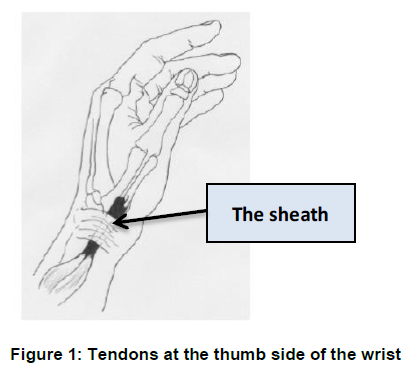De Quervain’s syndrome of the wrist
This page describes de Quervain’s syndrome (also known as de Quervain’s disease or de Quervain’s tenosynovitis) and the symptoms it may cause. The information will help you to understand the treatment available to reduce your symptoms.
What is de Quervain’s syndrome?
This condition results in the sheath covering the tendons on the thumb side of the wrist becoming thickened and painful.
The sheath acts as a tunnel that holds the tendons in place. This allows them to slide up and down freely when the wrist or thumb moves (Figure 1). When the sheath thickens, the tunnel becomes narrower and it is more difficult for the tendons to slide through. This can result in the tendons becoming inflamed and often results in pain when using the hand.
What are the causes?
In many cases this can happen without a clear reason. Sometimes it is caused by gripping for long periods with the wrist bent forwards or to one side. It can also be caused by rapid, repeated movements of the thumb and/or wrist for long periods of time.
The start of de Quervain’s syndrome sometimes follows after a blow to the outside of the wrist.
De Quervain’s syndrome is most common in people between the ages of 30 and 55 years, although it can happen at any age. Women are 3 times more likely to be affected than men, particularly those who have a young baby. It is not known whether this is due to hormonal changes as a result of pregnancy and childbirth, or due to lifting and carrying or feeding the baby.
What are the symptoms?
Pain is felt at the base of the thumb and side of the wrist. It is usually worse when moving the wrist sideways while gripping with the thumb. There may be swelling or a firm lump at the painful spot. Clicking, grating or snapping sounds are sometimes heard or felt with movements of the thumb and wrist.
How is de Quervain’s syndrome diagnosed?
The diagnosis is usually made based on the symptoms and by simple tests involving movements of the wrist and thumb.
What is the treatment?
- Activities which cause pain should be adapted. You may need to change the position of your hand and wrist during work and leisure. You should take regular breaks during gripping activities.
- Supporting the affected area using a splint, which includes the wrist and thumb, can be helpful. Your hand therapist can give you advice about the most suitable type of splint.
- Over-the-counter pain relief and/or anti-inflammatory medication may help to control the symptoms. Ask your pharmacist or GP for advice.
- Once the pain has started to settle, exercises to strengthen the muscles around the wrist and thumb should be gradually introduced. Your hand therapist will advise you.
- A steroid injection into the tendon sheath may be helpful if other treatments have not been successful. Some patients may need more than 1 injection.
For most people the symptoms eventually settle with one or more of the treatments above, but very occasionally a small operation is needed.
Contact information
Therapy Department
Cheltenham General Hospital
Tel: 0300 422 3040
Monday to Friday, 8:00am to 4:00pm
Gloucestershire Royal Hospital
Tel: 0300 422 8527 or
Tel: 0300 422 8588
Monday to Friday, 8:00am to 4:00pm
Further information
For further information about tendon injuries (including de Quervain’s), please go to the following website:
NHS Choices
Website: www.nhs.uk/Conditions/Tendonitis/Pages/Symptoms.aspx
